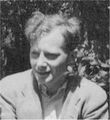Template:Selected anniversaries/January 9: Difference between revisions
No edit summary |
No edit summary |
||
| Line 2: | Line 2: | ||
||1349: The Jewish population of Basel, believed by the residents to be the cause of the ongoing Black Death, is rounded up and incinerated. | ||1349: The Jewish population of Basel, believed by the residents to be the cause of the ongoing Black Death, is rounded up and incinerated. | ||
||1586: Paul Wittich born ... mathematician and astronomer whose Capellan geoheliocentric model, in which the inner planets Mercury and Venus orbit the sun but the outer planets Mars, Jupiter and Saturn orbit the Earth, may have directly inspired Tycho Brahe's more radically heliocentric geoheliocentric model in which all the 5 known primary planets orbited the Sun, which in turn orbited the stationary Earth. Diagram | ||1586: Paul Wittich born ... mathematician and astronomer whose Capellan geoheliocentric model, in which the inner planets Mercury and Venus orbit the sun but the outer planets Mars, Jupiter and Saturn orbit the Earth, may have directly inspired Tycho Brahe's more radically heliocentric geoheliocentric model in which all the 5 known primary planets orbited the Sun, which in turn orbited the stationary Earth. Pic: Diagram. | ||
||1757: Bernard Le Bovier de Fontenelle born ... author and an influential member of three of the academies of the Institut de France, noted especially for his accessible treatment of scientific topics during the unfolding of the Age of Enlightenment. Pic. | ||1757: Bernard Le Bovier de Fontenelle born ... author and an influential member of three of the academies of the Institut de France, noted especially for his accessible treatment of scientific topics during the unfolding of the Age of Enlightenment. Pic. | ||
| Line 45: | Line 43: | ||
File:Charles-Émile Reynaud.jpg|link=Charles-Émile Reynaud (nonfiction)|1918: Scientist, inventor, and educator [[Charles-Émile Reynaud (nonfiction)|Charles-Émile Reynaud]] dies. He invented the Praxinoscope (an improved zoetrope) and was responsible for the first projected animated films. | File:Charles-Émile Reynaud.jpg|link=Charles-Émile Reynaud (nonfiction)|1918: Scientist, inventor, and educator [[Charles-Émile Reynaud (nonfiction)|Charles-Émile Reynaud]] dies. He invented the Praxinoscope (an improved zoetrope) and was responsible for the first projected animated films. | ||
||1921: Konstantin Mereschkowski dies ... biologist and botanist, active mainly around Kazan, whose research on lichens led him to propose the theory of symbiogenesis. Pic. | |||
||1922: Har Gobind Khorana born ... biochemist. He shared the 1968 Nobel Prize for Physiology or Medicine with Marshall W. Nirenberg and Robert W. Holley for research that showed the order of nucleotides in nucleic acids, which carry the genetic code of the cell and control the cell’s synthesis of proteins. Pic. | ||1922: Har Gobind Khorana born ... biochemist. He shared the 1968 Nobel Prize for Physiology or Medicine with Marshall W. Nirenberg and Robert W. Holley for research that showed the order of nucleotides in nucleic acids, which carry the genetic code of the cell and control the cell’s synthesis of proteins. Pic. | ||
Revision as of 15:14, 8 March 2019
1799: Mathematician, philosopher, theologian, and humanitarian Maria Gaetana Agnesi dies. She is credited with writing the first book discussing both differential and integral calculus.
1848: Astronomer Caroline Herschel dies. She discovered several comets, including the periodic comet 35P/Herschel-Rigollet, which bears her name.
1894: New England Telephone and Telegraph installs the first battery-operated telephone switchboard in Lexington, Massachusetts. (Shown here: another telephone exchange circa 1900.)
1917: Mathematician and philosopher Georg Cantor publishes new theory of sets derived from Gnomon algorithm functions. Colleagues hail it as "a magisterial contribution to science and art of detecting and preventing crimes against mathematical constants."
1918: Scientist, inventor, and educator Charles-Émile Reynaud dies. He invented the Praxinoscope (an improved zoetrope) and was responsible for the first projected animated films.
1955: Mathematician and criminologist J. H. C. Whitehead publishes a new class of Gnomon algorithm functions which detect and prevent crimes against mathematical constants.
1989: Mathematician Marshall Harvey Stone dies. He contributed to real analysis, functional analysis, topology, and the study of Boolean algebra structures.
2018: The Museum of Greedy algorithms runs over budget, demands emergency bailout from APTO (Algorithmic Paradigm Treaty Organization).







